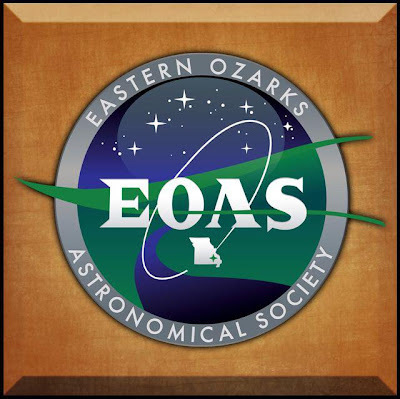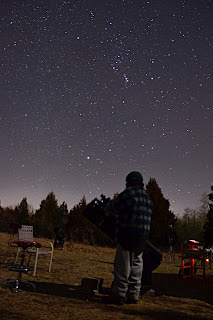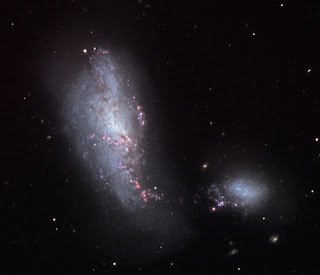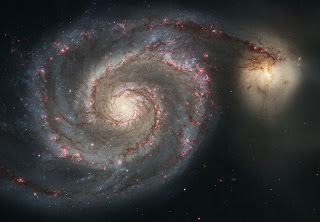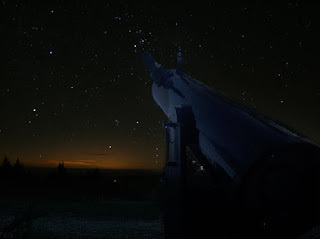Science
- Fighting for funding in Congress
- Developing new technologies to deflect asteroids
- Hunting for Earth-like planets
- Searching for intelligent life in the Universe
- Creating a global network of EarthDials
- And flying our very own solar sail spacecraft, Lightsail-1.
- Did you use direct or averted vision?
- What is the overall shape?
- Is the core noticeable, compact, stellar ? Can structure be seen in the galaxy, mottling, bright or dark patches or lanes?
- Are the outer edges sharp or diffuse? Identify any other DSO in the field.
- Did you use direct or averted vision?
- Is the core bright, compact, or not distinguishable? Is it highly or loosely concentrated?
- Is any part of it resolved into stars, averted vision or not, or does it show mottling, or stars resolved at the edges?
- Identify any other DSO in the field.
- Is it easily distinguished from the background stars, is it well defined?
- Is there a overall shape?
- How many stars can you count in the cluster?
- Are the stars concentrated in any one area?
- Is the cluster fully resolved or is background nebulosity noticed?
- Are there areas where stars are absent in the cluster? Are there any brighter stars in the cluster and do
- any stand out in color?
- Identify any other DSO in the field.
- Did you use direct or averted vision to view the cluster and nebulosity, are filters needed? What is the overall shape?
- Are the outer edges sharply defined?
- Can both the cluster and nebulosity be seen with direct vision, or is averted vision or filters needed? What is the overall shape?
- Are the outer edges sharply defined?
- Are the stars concentrated in any one area?
- Is the cluster embedded in the nebulosity or is there a distinct separation?
- Is any part of the nebula brighter or more concentrated?
- Are there any voids or dark patches or lanes, bright filaments or streamers in the nebulosity?
- Identify any other DSO in the field.
- Did you use direct or averted vision? filters needed? What is the overall shape?
- Are the outer edges sharply defined?
- Is any part of the nebula brighter or more concentrated?
- Are there any voids or dark patches or lanes, bright filaments or streamers in the nebulosity?
- Is there an open cluster nearby or involved or any obvious stars involved with the nebulosity? Identify any other DSO in the field.
- What is the overall shape, is it disk shaped or more stellar?
- Are the edges sharp or diffuse?
- Is it easy or difficult to identify in the field?
- What is the color of the Planetary?
- Is the center brighter, darker or uniform brightness as the edges?
- Identify any other DSO in the field.
How and why to record your astronomy observations
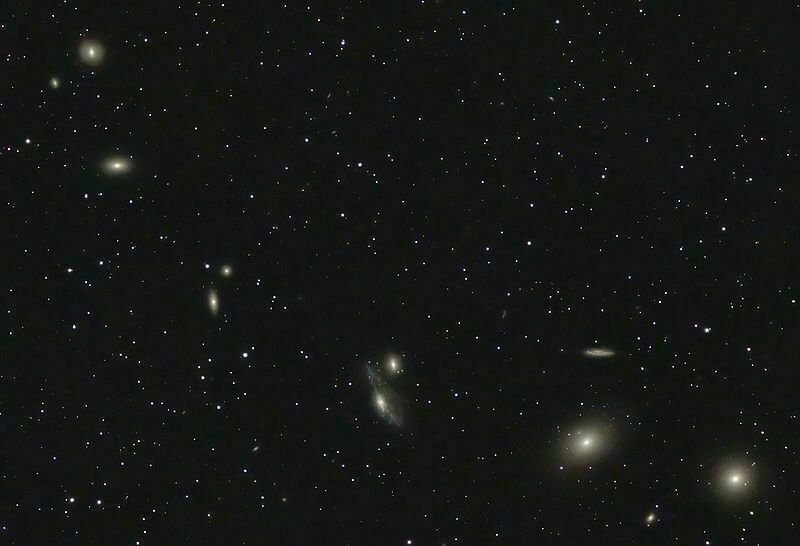 |
| M84 is the last, in the bottom right of this chain. M86 is the large, slightly oblong galaxy to the left of M84. |
In looking through the notes that I did record, starting sometime in November, I realize now what a poor job I was doing. I expect I may one day look back at my current notes and think the very same thing. Here's an example. For M84 my description was simply "A fantastic cluster of galaxies - beautiful." That's not the correct way to do it. For starters, M84 is a single galaxy that is a part of a string of galaxies called the Markarian Chain. It would have been fine for me to describe it as a part of that chain but I should have included a description of the object too. Probably something along the lines of "M84, a lenticular or elliptical galaxy, presents as a spherical halo with a stellar core." That is still a pretty basic description but it would be a step in the right direction. I could have added something about it's relationship to nearby M86, perhaps comparing the two and noting that M84 is more spherical with a slightly brighter core while M86 is slightly less bright with a more oblong shape. This is far more complete and will help me remember what it is I've seen.
As for the how of basic observation and recording, I use an iPad, spread sheet and database. Each observation gets logged into the spreadsheet on the iPad which is later entered into a FileMaker database. I record the date, time, atmospheric conditions, telescope used and eyepieces used. Lately I've also been recording temperature. Last is a brief 2-4 sentence description of the object and how it might appear in relation to other objects in the eyepiece. The more detail I can record the better I'll remember the observation when I read the description later. Also of great importance is that in recording observations, in looking for detail, we're actively training our eyes and brains to see better. The recording reinforces the observing skills and the increased observing skills, in turn, result in better written notes. One last thought, I also make it a point to at least skim the description of the object in Sky Safari as it often notes what should be visible in an amateur scope. I am also sure to study the image presented as a guide in observation of detail. The photos are far more detailed than what we can expect to see with our eyes but after a bit of practice I've learned to translate the images into more realistic expectations. They present the ideal of what is there.
Amateur astronomy, as I've written before, is a great way to learn some of the basic skills of science. Namely, the importance of consistent and methodical observation/data collection as well as consistent and methodical recording of that data. Amateur astronomers regularly contribute to the collection of data used in the field and with citizen science projects such as Zooniverse they are also helping to analyze the data collected by the many space telescopes currently collecting vast amounts of data. Whether they are finding NEOs (near earth objects such as asteroids) or finding exoplanets, amateurs are contributing to the science. It requires a certain level of observational skill, a willingness to increase that skill, and time. That's about it. Well, actually, it can be quite a bit more complicated and the time involved can be great if one is serious about certain areas such as the search for NEOs which requires not just detailed observation but consistent and methodical photography.
One last point. For anyone getting involved in amateur astronomy there is the side benefit of not only paying closer attention to what is being done by scientists in the field but also a very real-world personal benefit of a much deeper, more meaningful understanding of how science works generally and just how complicated the work really is. I can say that in just a few months my level of understanding, though still pretty basic, has been greatly increased and my appreciation for the work of NASA and others is now on an entirely different level.
Dark Skies to you!
Eastern Ozarks Astronomical Society Updates!
EOAS member Corey Warner of Studio 222 designed a fantastic logo for us and Karen Whitener was interviewed, for J-98, for one of the regional radio stations which will be airing the spot several times so that will help get the word out as well. Thanks to Scott Kubala of J-98 for taking an interest in our project. I also set up the Eastern Ozarks Astronomical Society website to seal the deal!
We've got many evenings ahead of us and I expect that they will each be filled with the joy that seems to come with the shared exploration of the universe. Dark Skies!
Exploring the Universe Together
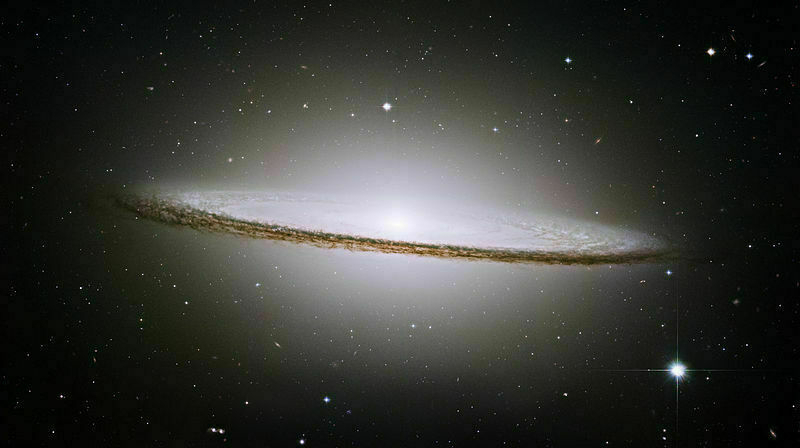 |
| NGC 4594, the Sombrero Galaxy |
What I enjoy most about being an amateur astronomer is learning about the Universe through a blended process of observing distant objects and then reading about those objects in the Wikipedia which is usually supplemented by a related episode of Astronomy Cast. It adds so much to my life to be able to look up through a telescope and view the Sombrero galaxy, to really take it in and ponder its existence. I wonder, who may be there and are they looking out in this direction? In my last viewing of that galaxy I spent nearly 30 minutes allowing my eyes to adjust and taking the time to notice the details. After a time of looking through the scope and seeing so many beautiful objects, supplemented by the research, I can say that now when I look up with my naked eyes I see it all very differently. There is now a deeper awareness brewing in me, fermenting knowledge, of the details and I more fully appreciate what I see and the emotions I experience as a result.
But of course we don't explore this Universe alone do we? At the forefront we have a global community of scientists cooperating and collaborating and challenging one another through this amazing process we call science. This open community, based on finding the mistakes and correcting the theories and adding in the details as they are discovered with newer, better instrumentation, sets the example for how we can better get at the truth. It is a never ending process, an ongoing adventure and exploration of our Universe and one we can all take part in. Those of us that are not scientists have a role as well.
As citizens of our planet it is our responsibility to make our own effort to learn and to explore. It is our responsibility to reach out, to share and engage with one another and with the knowledge being produced. The internet is allowing for increased communication between the public and the scientific community. For those interested in astronomy and related fields there are the sites I mentioned a couple days ago: CosmoQuest, the Planetary Society and the Citizen Science Alliance, all of which have at their core mission an attempt to engage the public and even to create a space for them to participate. Most of these groups are also involved with Google+ hangouts which allow for real-time video conferencing with the scientists doing the work. If you can't be around to watch live they are all archived on YouTube. For example, here's the Planetary Society's Channel.
There is an essential trait that we need to borrow from the scientific community before we can move forward: a willingness to embrace our mistakes and our ignorance. It seems to have become a common cultural trait to fear our fallibility but such fear holds us back from moving forward as individuals as well as collectively. Not so in the scientific community which is based upon a willingness to fail and a recognition that with failure comes knowledge and a better understanding of the Universe. It is in the moment of embracing failure, mistakes, and ignorance that we grow.
It is perhaps one of the great failings of the past 60 years that we have come to think of ourselves as alone and with that we have come to feel isolated, alienated. In that kind of world it is easy to become fearful and when we live in a culture of fear and insecurity we tend to avoid failure. We avoid growth out of fear of failure and we avoid accepting our mistakes because to do so is to admit we are fallible.
Fortunately, for us, the Universe that we actually inhabit is not one in which we can ever be alone or alienated, at least not physically. We might come to feel separated and alone in our minds due to our perception and our culture, but as far as the reality of the physical Universe that we live in, we are all very much connected:
When I look up at the night sky and I know that, yes, we are part of this Universe, we are in this Universe, but perhaps more important than most of those facts is that the Universe is in us. When I reflect on that fact, I look up — many people feel small, because they’re small, the Universe is big — but I feel big, because my atoms came from those stars. There’s a level of connectivity — that’s really what you want in life. You want to feel connected, you want to feel relevant. You want to feel like you’re a participant in the goings on and activities and events around you. That’s precisely what we are, just by being alive.” - Neil DeGrasse TysonIt is natural for us to share what we know or think we know and it is natural for us to be curious. It is these natural desires, coupled with critical thought and the scientific method that we can lift ourselves up and, just as importantly, lift one another up. We have great challenges before us but in teaching one another and encouraging one another we can do remarkable things. In our cooperation we have the opportunity to co-create something beautiful: each other.
We truly are in this together. There is no such thing as alone in this Universe and the sooner we remember that, feel that, and understand that, the sooner we can get on being whole again. We are but one species sharing this planet sharing this cosmos. I did not know Kaleesha or her husband or children until just a couple months ago and am thankful to Bill (another of our community and local librarian) for sending them my way when they indicated interest in astronomy. As a result they have become an important part of our little outpost of science advocates in this out of the way rural community. As long as I'm expressing my appreciation I think I'll also mention how happy I am to have connected to Frances, Russ, Angie and Karen, all humans with which I am grateful to have met since moving to this little corner of the Universe and who have shared the exploration with me.
Eastern Ozarks Astronomy Society First Night!
My friend Russ Middleton got some great photos and one of our new members, Kaleesha, and her girls had a look at a nice variety of nebulae: Orion, Pac Man, Eskimo and M1, the Crab. We also took a look at Jupiter and ended the group viewing with Bode's Nebulae, M81 and M82. Lots of great astronomy talk about the Cosmic Microwave Background, the Bing Bang, and how astronomers (and science in general) come to know things through the scientific method.
After everyone left I warmed up inside for a couple hours and went back out after the moon set. I logged 13 galaxies, a planetary nebula and a globular cluster, M68. Five of those were Messiers bringing my total on that list to 103, just 7 more to go! Messier 104, the Sombrero, was really impressive and with averted vision I was able to make out the dust lane. M68, was really beautiful with many of its stars nicely resolved. I also added nine more to my list of viewed Herschels, bringing me up to 241 out of 400.
The last object viewed from 4:20-5am was Saturn. This was, by far, the best view of the planet I've ever had in my life and honestly, I think I could have cried but it would have ruined the view so I didn't let it happen. It was so otherworldly, and yet, so familiar an image. Viewing Saturn is always special but when it is so perfectly clear, it can be much more.
I saw at least 5 of the moons as well as the Cassini Division in the rings, a first for me. Also saw clouds/color bands, another first for me. Sometimes language fails me.
I can think of no better way to spend a night than this.
Advocating for Science Literacy and Reason
I’ve always been a big fan of getting at the truth of things no matter how inconvenient or uncomfortable we may be getting there. It’s something I’ve insisted on and many times in my life it has caused me a good bit of trouble. That said, I don’t feel I have much choice in the matter. It’s the activist and the radical in me. It is, perhaps sad, that insisting on the truth might, today, be considered radical. I suppose when you look at the definition of “radical” it does speak to the search for truth. According to the New Oxford American dictionary, radical is: “relating to or affecting the fundamental nature of something; far-reaching or thorough.”
In recent months my small town life got a bit rough in terms of some of my relationships. Specifically, those relationships which I’d developed with local conservatives. It was my intent to cross lines, to try to relate to my fellow humans as humans regardless of their political or cultural leanings. As a result, I’d gotten to be “friends” with quite a few folks that I tended not to agree with on many things. They knew and I knew those differences existed but we made a go of it. But eventually those differences presented themselves front and center and some of those friendships ended in turmoil.
What I am coming face to face with in rural Missouri is the hard truth that many rural residents are not comfortable with having their beliefs challenged, most notably their religious beliefs. Some are able to co-exist with science and accept the possibility that their belief in a higher power can be retained along with an acceptance of science. Others don’t seem able to bridge the gap but tend to remain neutral. Some are resistant to the point of hostility.
I have pondering for some time what seems to be an innate tension that exists between religion and science. This is a very real and very serious problem and manifests itself in important and basic elements of science education, namely the teaching of the Big Bang, evolution and climate science. Creationism and intelligent design (a version of creationism promoted by the Discovery Institute) are not, in any way, valid alternatives to evolution. Nor does the fundamentalist Christian community provide any kind of explanation or description of the origin of the universe and yet, they have established an influence in public education on this as well. While the U.S. has downgraded and simplified math and science education other countries are making great progress.
My intent here is to explicitly advocate for science literacy and reason. Evolution, the Big Bang, climate change are all areas of science that have been, to a great degree, settled. While there are many in this and other rural areas who do understand the importance of science as a method for understanding the world and as a basis of progress, there are many who do not. A part of the problem comes from the churches, from organized religion who are crossing lines in terms of social and political advocacy which cannot be tolerated. Another part of the problem is the confused and sloppy thinking that comes from religious belief. I would argue that religion, as it is based on faith, actually requires a level of rejection of reason and the scientific method. At the core, science is the search for truth while religion is advocacy of a belief in something that can never be shown to be true.
I’d like to explicitly support a few organizations that are doing important work that you can support and in some cases actually participate in via citizen science projects.
CosmoQuest is one of my favorites. From their website:
Another is the National Center for Science Education.Our goal is to create a community of people bent on together advancing our understanding of the universe; a community of people who are participating in doing science, who can explain why what they do matters, and what questions they are helping to answer. We want to create a community, and here is where we invite all of you to be a part of what we’re doing.There are lots of ways to get involved: You can contribute to science, take a class, join a conversation, or just help us spread the word by sharing about us on social media sites.Like every community, we are constantly changing to reflect our members. This website will constantly be growing and adding new features. Overtime, we’re going to bring together all the components of a research learning environment (aka grad school), from content in the form of classes, resources, and a blog, to research in the form of citizen science, to social engagement through a forum, social media, and real world activities.
The National Center for Science Education (NCSE) is a not-for-profit, membership organization providing information and resources for schools, parents, and concerned citizens working to keep evolution and climate science in public school science education. We educate the press and public about the scientific and educational aspects of controversies surrounding the teaching of evolution and climate change, and supply needed information and advice to defend good science education at local, state, and national levels. Our 4500 members are scientists, teachers, clergy, and citizens with diverse religious and political affiliations.
Last but not least is The Planetary Society, co-founded by Carl Sagan and currently headed by Bill Nigh.
The Planetary Society sponsors projects that will seed innovative space technologies, nurture creative young minds, and be a vital advocate for our future in space.
Why we do it
Our Mission is to create a better future by exploring other worlds and understanding our own.
Current projects include:
Interested in getting your hands dirty with some citizen science? Of course you are! Check out the Zooniverse which is a project of the Citizen Science Alliance.
OriginMy favorite thus far is Planet Hunters which I have participating in. It’s very easy and exciting to know that I’m actually doing some of the preliminary work required to find planets around distant stars.
The Zooniverse began with a single project, Galaxy Zoo , which was launched in July 2007. The Galaxy Zoo team had expected a fairly quiet life, but were overwhelmed and overawed by the response to the project. Once they’d recovered from their server buckling under the strain, they set about planning the future!
Galaxy Zoo was important because not only was it incredibly popular, but it produced many unique scientific results, ranging from individual, serendipitous discoveries to those using classifications that depend on the input of everyone who’s visited the site. This commitment to producing real research - so that you know that we’re not wasting your time - is at the heart of everything we do.
Real Science Online
The Zooniverse and the suite of projects it contains is produced, maintained and developed by the Citizen Science Alliance. The member institutions of the CSA work with many academic and other partners around the world to produce projects that use the efforts and ability of volunteers to help scientists and researchers deal with the flood of data that confronts them.
Of course there are others but these are the ones I wanted to mention today.
From the post at Earth Sky:
At the end of each year, the National Oceanic and Atmospheric Administration (NOAA) releases a report card on the state of the Arctic. In 2012, NOAA reports record low levels of sea ice extent, lower than we’ve seen before since the satellite era began in 1979. Plus, in June 2012, the Arctic experienced record low snow extent across the region. Greenland saw extreme melting during the summer of 2012, and the warmer temperatures and decreasing ice provided massive phytoplankton to grow. NOAA scientists said that air temperatures were on a par with the (relatively high) temperatures of the last decade, leading to, among other things, an increase in the length of the growing season along with tundra greenness in the Arctic. Climate models suggest that, in a warming climate, high latitudes such as the Arctic will be affected first, and so it seems to be. The 2012 Arctic Report Card is a peer-reviewed report that consists of 141 authors from 15 countries. If you ask a scientist who travels periodically to the Arctic or across Greenland, he or she will tell you that the landscape there is changing dramatically from year to year.
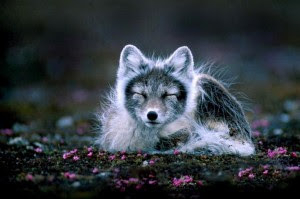 |
| Arctic fox at Svalbard, Norway. In Fennoscandia, fewer than 200 individuals are estimated to remain. |
We, as a species, are nothing short of criminal.
Geminids and Galaxies
During the course of the evening I looked at 17 galaxies, 1 globular cluster and easily 100+ meteors. I was looking through the scope most of the night but in the short times I was looking up with just my eyes I would easily see 1-3 a minute sometimes more or less, depending on the time of night.
All together, about 9 hours looking up :)
Finding Bliss in the Universe
Between the moon at the first of the month and the nearly constant cloudiness it’s been hard getting any kind of extended time at the scope. Last night was fantastic and it looks like the forecast for the next 2-3 nights looks great.
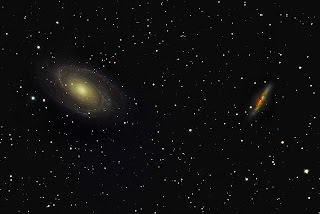 |
| M81 and M82 |
I’ve always, as long as I can remember, taken note of and appreciated the stars in the night sky. Today, at 43, I can say that I truly understand who and what I am in this universe. Well, I more fully understand. True understanding is just the goal of the process. To be a living being on this beautiful planet, just one of many trillions of planets in the universe, is so amazing. I sometimes feel a bit guilty that I am able to experience such bliss in my life. Wether walking in the woods or looking up at the stars, leading such a simple life and being a part of the greater universe, I can ask for nothing more.
And about last night’s viewing session? I was happy to view thirteen more objects in the Herschel 400 as well as a swing by the two galaxies known as Bode’s Nebulae and a quick view of the Double Cluster in Perseus! Last but not least, Jupiter. I probably spent twenty minutes looking at Jupiter and I have to say, it never get’s old. Each time, each moment, is breath taking. On a good night such as last night, the 5mm EP is fantastic for viewing this beautiful neighbor of ours. The cloud bands and the GRS are crisp and easy to see. Wonderful.
As I spend more time outside at night I am consistently seeing more with my naked eyes, especially on nights with good seeing. Last night, at various points between looking through the EP, I really made it a point to enjoy the naked eye view. In particular, I spent some time gathering up the faint stars and the fuzzy Messier objects. For example, the Beehive Cluster in Cancer was so easy and obvious to see. In fact, I wasn’t even looking for it but was just scanning the sky and it stood out to me. The Double Cluster in Perseus was also an obvious and easy to see object with the naked eye.
A special note about Bode’s Nebulae: What a sight to see them together in one eyepiece! At 11 million light years distance, M81 offers a face view and is interacting with M82 which is a prototype starburst galaxy presenting an elongated view. After weeks of focusing mostly on small and faint galaxies and clusters, anytime I come upon the more easily seen objects I always find myself surprised at just how beautiful and defined they are! These two are a great example of that. I have no doubt that it is just the slow improvement of my viewing skills and my greater awareness of the range of faint objects.
Dancing with the clouds
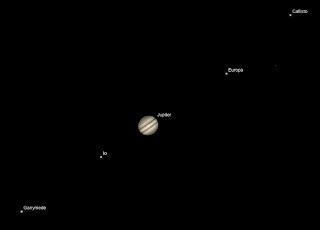 |
| Image of Jupiter from SkySafari |
Normally, I would not have bothered with such a mixed night but we've had 10 days of pretty cloudy weather and with a few clear nights blotted out by the moon. I was desperate.
 |
| Sigma Orionis |
Couple hours later, about 10:30pm, I saw Karen post on the FB about being outside viewing so I went out: totally clear. Curse words. Get eyepieces and make a dash for the telescope. Set-up. Sit down. Clouds. More curse words. Wait. Look around. Decide there is enough clear sky to stay out. I spent the next 2 hours, maybe 3 hopping away from clouds, trying to find a few things before being foiled. Lesson learned? If you're desperate and willing to dance with the clouds for awhile, there might be a reward.
I got a fantastic view of Jupiter in the 5mm EP. The cloud bands were crystal clear and I was able to easily make out 3-4 bands. Unfortunately no GRS as it was on the other side of the planet. I also had a good viewing of a couple of planetary nebula. NGC 1535, Cleopatra's Eye, was particularly good. It is a bright blue sphere and with the 5mm EP a bright central core is easily visible. Of course the moon was out so anything faint was out of the question. I ended the night with a great shot of Sigma Orionis, a 5 star (only 4 viewable) system in Orion. Not my photo but this is exactly what I saw. Very cool.
Observational Astronomy: The basic skills of science
I’ll be honest, when I ordered my telescope in September I had no idea what I was getting myself into. I had no agenda other than to have a way to look more closely at planets, galaxies and other objects in the night sky. Pretty simple really. After the first few sessions with the telescope I started thinking that I should keep track of the objects I was viewing. I started doing that but then realized I could probably be recording more than a simple list of what I was viewing. So I started keeping track of the date and time of the observations. Well, why not note which eye pieces I was using too? Ok. Check.
At the two week mark I’d done enough reading to see that there were organized observational “programs”, essentially, lists created to help guide and teach amateur astronomers how to go about learning observational astronomy. So I did a bit of checking and saw that in those programs they also record atmospheric conditions such as “transparency” and “seeing” as well as free form observational notes. Okay, why not?
Fast forward to today. I’ve been consistently recording each observation, 211 thus far, but realized that I was not recording much in the way of a free form description. Some people sketch what they see and I may try that in the future but for now I’d rather use words. The problem? I don’t really have the skills to properly describe what I’m seeing. More to the point, I don’t have the vocabulary which, in a sense, is also the instruction set for observation. The vocabulary is the framework. While this is just the most basic example of one step of the scientific method I think it is useful to recognize it as such. Amateur astronomy, if combined with just a little bit of discipline, can be a valuable experiential tool for learning observation skills.
So, I spent the morning searching around and have made some progress. Because I am a nerd I must of course share in the hopes that someone will find this useful. This particular bit of information is specifically helpful for the observation of deep sky objects. Planetary and other solar system observation of comets and meteor showers is a different set of concerns and techniques!
The below is just one page from a nice set of very informative pdfs over at Astronomy Logs.
Galaxies
On being agnostic
When it comes to questions of god or spirituality I have, more often than not, been quiet on the subject. I’ve had plenty of conversations about it with friends and family and certainly don’t mind discussing it when asked. But I don’t generally shout it from the rooftops or buy billboards or create commercials for TV. In contrast I’ve been subjected to a constant stream of of ads in print, billboards and on television telling me that I need Jesus and that Mormon’s are awesome.
Enough. I’m done being silent. I’m fed up having religion pushed on me and being told I would burn in some nasty hot place down below. Fed up hearing about how there is a war on Christmas and Christianity. I call bullshit. If you want to believe in unicorns or the flying spaghetti monster or a Beluga Whale named Marv that can heal the sick with a wink, please, be my guest. But please, do you have to convert me? Must you push and push and push your belief into every corner of the planet?
Let me offer a few observations on your religion (if you have one).
1. It is, quite simply, make believe. I say this because religion is, more often than not, based on a book of some sort written by a guy (usually) or a group of guys (usually) that made it all up. Seriously. They made it up. No proof at all. I went up into the hills and heard a voice. On and on and on.
2. In any good creative story there is revision and boy do we have plenty of that. From year to year, decade to decade the rules change. Oh, you can do that now because some white dude in a closed room with other white dudes decided it is now ok. Or it’s not. I can’t remember. But, apparently these fellas have a hotline to the big fella in imaginaryville. It seems a bit fishy to me. No Marv, I was not offering you a fish.
3. Why the aggression? In it’s most recent form it is very interesting to look at the religious right in the U.S. They are in a constant cultural war against those that are different from they. I don’t doubt that much of this is a part of a scheme of distraction by those in power that would much prefer the vast sea of poor people fight amongst themselves but nevertheless it is a constant wave of aggression that often spills over to actual violence against very real people who’s sole crime is being gay or different from the believer in some way. Yes, apparently it’s okay to hurt people.
4. Why the violence? Yes, the aggression spills over to violence. Be it war or hate crimes, the history of religion is chock full of violence. I don’t think I need to create a sub-list here do I? Jesus carried a machine gun you say? Why not, it’s no sillier than all the other stuff he did. And Jesus said unto Marv, “I have no fish today."
I could go on with this list and I probably will at some point in the near future. My reason for bringing this up today is that I’ve recently had a string of interactions with religious folks that pushed me to the conclusion that organized religion really does require a kind of willful ignorance and a partial if not nearly absolute suspension of critical thinking. There is a fear of the unknown. As the thinking goes, if I don’t immediately understand a particular phenomena it’s better to construct a story about how a wizard in the sky created said phenomena.
This is where science comes in. We don’t have to rely wizards an whales to make sense of the world around us. Just as Copernicus and then Kepler and Newton successfully challenged the make believe constructions of the church 500 years ago, today’s scientists are, everyday, moving our understanding of how the universe works forward. The scientific method is a fantastic tool in that it is the basis for getting at the truth. No, we don’t have it all nor will we ever. It is an exploration and the point is to make the effort. At no point is it helpful to step back and say, I don’t understand this right now so it cannot be explained and must be the work of a higher power. That is the moment of giving up and choosing to fill a gap in knowledge with silly putty. It’s not necessary. It is perfectly ok for us to have gaps in our understanding. There will always be such gaps and that’s what moves us forward.
So no, I won’t be accepting Jesus Christ and I sure wish you’d stop telling me I should. I’m not making a war on your religion though I find it interesting that you are so quick to think war is being made upon you. What I AM doing, in response to your constant crowing, is a bit of my own tweeting. Tweet tweet. Translation: there is no proof that there is a god. In many thousands of years no proof has been offered. Furthermore, your churches have historically, and are this very day, attempting to stand in the way of our understanding the universe. Please stop.
Climate Change and Science Literacy
UNEP Greenhouse Gas Emissions Report Finds Climate Change Goals Growing More Elusive:
Global greenhouse-gas emissions already have passed the point where the worst effects of global warming could be averted, and they are still rising, according to the third annual United Nations report on the so-called emissions gap.We, as citizens lack the understanding and the will to make the changes necessary in our own lives. “Our” government is also unwilling to do what needs to be done. Over. It won’t just be our children and grandchildren that will suffer, we all already are. It’s true that no particular storm or weather event can be attributed to man made climate change but the science is pretty clear that we are already feeling it in our obviously changing weather patterns.
Some countries have made pledges to help reverse this trend by lowering their emissions. However, the report by the U.N. Environment Programme warns that the gap between these pledges and reductions necessary to cap average global warming at 2 degrees Celsius (3.6 degrees Fahrenheit) by 2020 continues to widen.
Which brings me to my next topic: science literacy. We are in this position because science is slow and takes time and because people do not understand the basic scientific process. Without an understanding of how science works people are easier to manipulate on issues that require such an understanding. In this case various global industries that have benefited from the continued exploitation of fossil fuels have actively sought to confuse the public to protect their profit source.
It is unfortunate that capitalism does not prioritize the public good but that’s another topic for another time. Suffice it so say that capitalism has, thus far in it’s history, demonstrated that it does not seem to be able of co-existing with the needs of our planet’s ecosystems. Regardless of that discussion, we know that these industries have spent many millions of dollars to convince the governments and people in general that the science of climate change is uncertain. They have been very effective at exploiting a general lack of understanding of the specifics of climate science and science in general.
If we are to move forward we have to build a process and a system for teaching basic science literacy. At the very least we need for the adult citizens of our planet to have a basic understanding of the scientific method. Though that is just one part of minimal understanding it is fundamental and is the starting point for giving people the tools to evaluate the information (or disinformation) that is available.
To that end folks have been working in recent years on developing a global network of science cafes. In Madison County our little discussion group, fondly referred to as the Geek Parade has decided to open itself up a bit to the general public and will be making an effort at more organized, public discussions. We’ll be getting started in January 2013!
We have a long way to go. Science literacy in the U.S. is low as evidenced by such indicators as acceptance of evolution which is one of the lowest of all western nations, 40%. I’m excited that we’ve gotten the ball rolling in our county, but it is distressing that there are only 4 such groups in the state. Well, there are 4 that are a part of the Science Cafe network. There may be others which meet that I am, at the moment, unaware of that are not listed. Certainly there are various other groups such as astronomical societies that advance science literacy but it is not really the broad-based organized effort that is needed.
Baby steps.
The Whirlpool Galaxy
Even with the lighter sky I believe I was able to make out a hint of the spiral structure. M51 is not alone though, it has a neighbor galaxy, NGC 5195, with which it has been interacting for hundreds of millions of years. In fact it is believed that it is due to these interactions with NGC 5195 that the the spiral structure of M51 is so pronounced. Quite a pair!
In addition to the Whirlpool Galaxy I also got a look at two other Messiers, M89 and M90. I'll definitely revisit both of those when skies are darker. A bonus, the above mentioned NGC 5195 is a member of the Herschel 400! That brings me to 92 of 110 Messier objects and 112 of the 400 Herschels. Not to bad for just over two months of viewing!
Three months ago I would have told you that my brand new 8" Dobsonian telescope would be all I would need. Well, I can tell you, that as much as I enjoy the views that this scope provides, I am excited about someday seeing these objects with a 16" scope. So much of what is now a hint of structure will be far more obvious with a larger scope. That said, I'm happy to have started with the 8" and know that many people use such a scope for many years. It's good to know what is possible with this aperture and, in fact, learning to star hop with it has been a joy, viewing the faint fuzzies with it has required time and effort. I feel like I am earning my way to the next step and will, no doubt, more fully appreciate the better views of the larger scope when the time comes because of my starting point.
The Virgo Galaxy Cluster!
 |
| Messier 88 |
The Virgo Galaxy Cluster is about 54 million light years away and contains a minimum of 1,300 galaxies, possibly as many as 2,000. Viewing it with a telescope is fantastic... I just hopped from galaxy to galaxy. Normally I'm lost in the stars, this morning I was lost in galaxies! If there had been more time before the sunrise I could have easily stayed in this little area of the sky for many more hours. The number of galaxies is overwhelming.
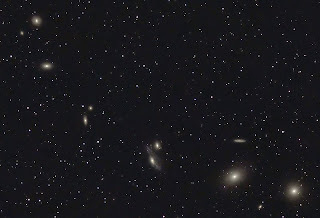 |
| Markarian's Chain |
My favorites of the night were Messier 88 in Coma Berenices as well as the various galaxies that make up Markarian's Chain. What a sight! Messier 88 actually shows a bit of structure though it is faint in my 8" telescope (and obviously nothing like the detailed image above).
I expect that my next 3-4 morning sessions will be spent in this cluster of galaxies. The moon will be setting later these next couple days so I'll have less time each day between moon set and sunrise. I hope to squeeze in another morning session tonight!
Astronomy Outreach at Antonia Middle School
This was my first time to attend a public star party and I'm happy to report it went over very well. I'd estimate attendance at 25-35 folks with 6 or so scopes and fairly clear skies. We had a bit of light cloud cover but it didn't last long. The area is subject to a bit of light pollution as well as a good bit of moon light but viewing brighter objects was no problem. I stayed on the Owl/E.T. cluster most of the night and am happy to report that everyone that viewed the cluster got a kick out of seeing the E. T. figure in the eyepiece! Other scopes were showing off Jupiter, the moon, and the Andromeda Galaxy.
All in all it was a successful event. I was thrilled to have a chance to meet several members of the SLAS. Of course I was quick to invite them all out to view from our dark skies in Madison County and am sure they'll take me up on the offer. I also received some excellent advice from one of the experienced members of the SLAS, John, on a few technical aspects of my scope. One of the great benefits of events like these are the opportunities for learning from more experienced members and I look forward to learning a great deal more from John and others. I'm also happy to report that I shared our efforts to build science literacy in Madison County via our Geek Parade and in discussing it with their members received at least one offer of a guest lecture/presentation to our group!
Stay tuned, more to come!
Pondering the Future
Specifically my personal future and also thinking a bit about this blog. I’ve obviously not been very consistent with updates. Honestly, I put some of the blame for that on Facebook. I’m sure I am not the only one who spends too much time there. While it is great for sharing I thing the downside is that much of that sharing is just reposting. I am also leery of so much content being under one roof so to speak.
So, still here. With the crazy heat and drought of this past summer my garden suffered as did the many trees and bushes I put in over the past four years. That said, almost all of my perennials survived even if they didn’t thrive. Luckily the veggie garden was, by chance, smaller. The climate future looks increasingly scary for those of us that want to eat food, wink wink.
As for my project here, it will continue for the time being though I struggle to remain enthusiastic with the annual veggies. Something about three months of intense drought and heat seems to make my garden time outside a bit less enjoyable. Our well is shallow which means I either need to haul water from the lake or invest several thousand into a new well. Climate change is ugly.
So, I’m thinking that it is time to add in a new element of activity which reflects a new interest (actually a childhood/life interest that has been sitting in a corner of my mind): astronomy! Well, science in general, but astronomy especially. While I have no intention of abandoning the permaculture work I think having another primary activity is a good thing and in the winter when growing is out I’ll have something very interesting to explore, namely, our universe.
Which brings me back to one my thoughts on the blog. I’ve not been consistent in writing about my permaculture/homestead efforts but do think I might be more consistent in reporting on my astronomical explorations as it is the sort of interest that lends itself to data collection and reporting. Should I do that here as a supplement to my other interests or do I start an astronomy based blog? Actually, I think I just sorted it out as I write. I’ll keep it here but will not just add in my astronomical observations but will also add in other science related material.
Actually, and don’t laugh, but I have this vision of humanity (or myself?) that connects to a few episodes/films from Star Trek that have always stuck with me. In particular, those which seem to showcase small, egalitarian villages in which science seems to not only co-exist with daily life, but informs a deeper and greater understanding of the relationship between humans and nature and the larger universe. Contrast this to our modern manifestation which seems to have largely become a tool for corporate profit with little regard to ethics. A great example would be GMOs and modern industrial agriculture as it might compare to a decentralized permaculture-based system informed by local and thoughtful observation.
One outlook, the modern corporate/capitalist/industrial, uses science primarily as a tool for the accumulation of wealth. The other uses science as a method for deepening our understanding of the natural world around us not just for technological development, but for the sake of understanding. In this second outlook the ethics of use would be an important part of the overall process and would include all sorts of new questions and concerns in any sort of possible application of scientific knowledge. In fact, one might say that the second view represents a kind of democratization of applied science.
Wow. I didn’t expect to take this post in this direction but it is interesting and it is something I’ve thought about off and on over the years so, yeah, I’ll be back to this at some point. Another area that I’d like to explore is science literacy and critical thought. There has been a long trend in the U.S. which seems to be gaining a bit of steam when, in fact, it should be losing steam and that is the movement against science. Such a movement can only happen when there is a lack of communication of knowledge. When people are ignorant of established scientific knowledge and the basic method which serves as its foundation there is room for manipulation.
So, you can expect that I’ll be spending some time discussing not just science but specifically science literacy. I’m not a trained scientist but I think I know enough to discuss some issues as a citizen. Specifically I’m likely to dig into the entwined relationship of politics, religion and global capitalism have been used to undermine science literacy to further their capacity as control agents: social, political, economic, ecological… everything from the genetics of corn to humans, from crowd control to the “entertainment” that comes out of the glowing screens in living rooms. Science and technology can be used in many ways for many different and often opposing agendas. I think that will be some interesting exploration.
There is also some real life stuff I’m hoping to make happen that reflects all of this, specifically a few ideas for how I might further science literacy here in rural Missouri where it is greatly needed. I’ll share that as well.
